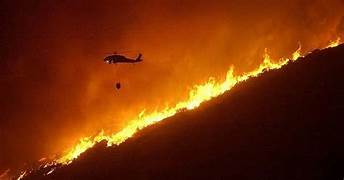On October 26, 2003, the United States faced a devastating natural disaster as a series of wildfires erupted across Southern California. The California firestorm, also known as the Cedar Fire, was one of the most destructive wildfires in the state's history, leaving a trail of destruction and loss in its wake. The Cedar Fire originated in the Cleveland National Forest and quickly spread due to a combination of dry conditions, strong winds, and steep terrain. The fire rapidly grew in size and intensity, fueled by the abundance of dry vegetation in the area. It eventually engulfed over 270,000 acres of land, destroyed thousands of homes, and claimed the lives of 15 people. The impact of the California firestorm was felt across multiple counties, including San Diego, Riverside, and Orange. Thousands of residents were forced to evacuate their homes as the flames consumed entire neighborhoods. The fire posed a significant challenge to firefighters, who worked tirelessly to contain the blaze and protect lives and property. The Cedar Fire highlighted the immense challenges faced by emergency responders in battling wildfires. The combination of strong winds, dry conditions, and difficult terrain made it difficult to control the spread of the fire. Firefighters had to navigate rugged terrain, endure extreme heat, and work around the clock to protect communities and prevent further devastation. The California firestorm also emphasized the importance of preparedness and community resilience in the face of natural disasters. As the fire quickly spread, local authorities issued evacuation orders and set up emergency shelters to accommodate displaced residents. The response efforts involved multiple agencies, including fire departments, law enforcement, and volunteer organizations, working together to provide support and assistance to those affected. Furthermore, the disaster prompted a reevaluation of fire prevention and mitigation strategies in California. The state's unique climate and vegetation make it prone to wildfires, and the Cedar Fire served as a stark reminder of the need for proactive measures to reduce the risk and impact of such events. This led to increased efforts in forest management, including controlled burns and vegetation clearing, as well as public education campaigns to raise awareness about fire safety and prevention. The aftermath of the California firestorm was a period of recovery and rebuilding for the affected communities. Residents faced the daunting task of rebuilding their homes and lives, while local and state governments worked to provide support and resources for recovery efforts. The disaster also highlighted the importance of insurance coverage and disaster preparedness for individuals and communities.
26 Oct, 2003 U.S.A. California Fire
